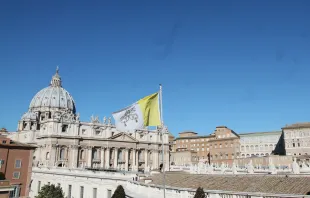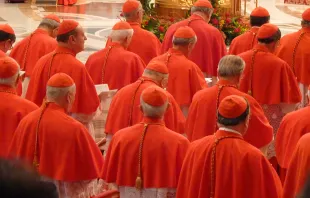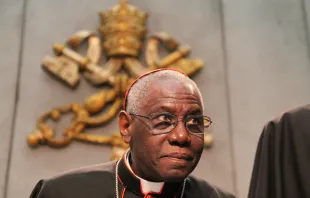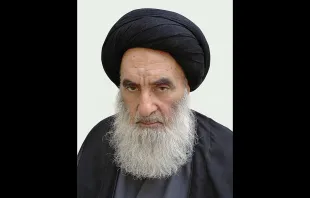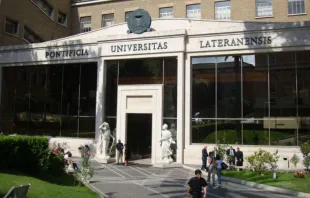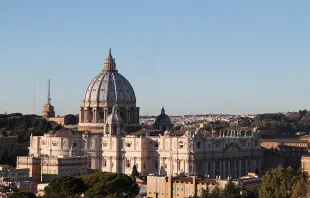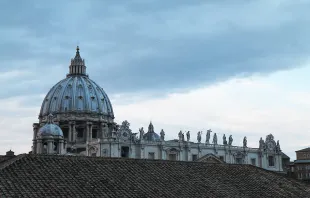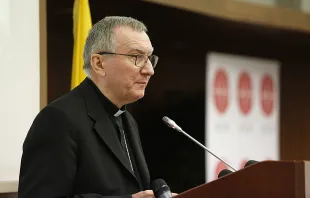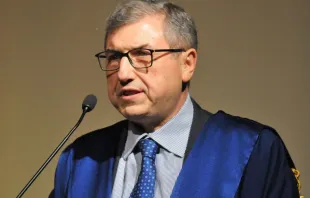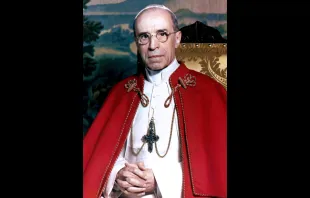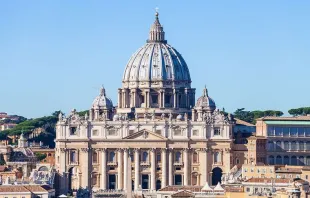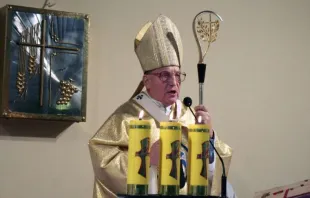Articles by Andrea Gagliarducci
Curial speculation follows papal meetings with bishops
Mar 6, 2021 / 08:10 amSources have told CNA that Pope Francis may choose two US-born prelates as prefects of congregations in the Roman Curia.
What changes may be coming to the College of Cardinals in 2021?
Feb 25, 2021 / 18:37 pmWhen Cardinal Gabriel Zubeir Wako turns 80 on Feb. 27, the cardinals eligible to vote in a conclave will drop to 127, seven more than the limit of 120 set by Paul VI and confirmed by John Paul II.
Who might be Cardinal Sarah's successor?
Feb 25, 2021 / 16:44 pmAfter Robert Cardinal Sarah's retirement as Prefect of the Congregation for Divine Worship and the Discipline of Sacraments, the big question around the Vatican is who will take his place.
French Catholic women launch manifesto on feminine vocation in the Church
Feb 20, 2021 / 15:11 pmA group of Catholic women in France has launched a manifesto to underscore the “beauty of the women's specific vocation.”
Apostolic nuncio accused of money laundering to enter plea bargain
Feb 9, 2021 / 17:01 pmArchbishop Ettore Balestrero, the apostolic nuncio to the Democratic Republic of Congo, announced last week that he will enter a plea bargain with an Italian court after he and his brother Guido were accused of money laundering, but will not admit guilt.
Who is Ali al-Sistani, the Muslim leader whom the Pope will meet in Iraq?
Feb 2, 2021 / 15:19 pmDuring his upcoming trip to Iraq, Pope Francis will meet with the Shia Muslim leader Ali al-Sistani, a man in his 90s who many international analysts consider a decisive player in the region since the end of the Iraq War.
In Facebook post, JPII Institute defends Biden’s abortion record
Jan 28, 2021 / 16:41 pmThe John Paul II Pontifical Theological Institute for Marriage and Family Sciences generated a flurry of controversy in the Italian Catholic blogosphere this week, after its Facebook page defended Joe Biden’s support of legal abortion.
Are changes coming to the Vatican Dicastery for Communications?
Jan 25, 2021 / 19:56 pmIncreasing rumors from multiple Vatican sources say the Vatican communications department might experience a shakeup shortly, and that Pope Francis might try a new redesign of the dicastery that handles Vatican media.
What changes to the Vatican may the replacement of the Archpriest of St Peter's Basilica bring
Jan 14, 2021 / 17:45 pmPope Francis might soon choose a new Archpriest of St. Peter's Basilica, to replace Cardinal Angelo Comastri, who turned 77 in September. His replacement, according to Vatican observers, may bring a broader generational change that could involve at least five Vatican dicasteries.
Vatican Secretary of State knew of investment now under investigation
Jan 12, 2021 / 11:57 amA letter by Cardinal Pietro Parolin leaked to an Italian news outlet shows that the Secretariat of State was aware, and approved at its highest ranks, of the disgraced purchase of a luxury real estate property in London now at the center of a Vatican investigation.
First lay head of disciplinary commission at Roman Curia appointed
Jan 8, 2021 / 16:40 pmFor the first time, the Disciplinary Commission of the Roman Curia will be presided by a layperson after Pope Francis appointed professor Vincenzo Buonomo, rector of the Pontifical Lateran University. And it is possible that more laypersons will be appointed for other Vatican positions.
Book gives more insight into the actions of Pius XII and his 'bureau' during WWII
Jan 7, 2021 / 16:00 pmA new book provides further information from the archives of Venerable Pius XII, including the Vatican’s attempts to oppose the actions of Nazi Germany through diplomacy during World War II.
After Secretariat of State shakeup, what’s next for Curia reform?
Jan 7, 2021 / 15:33 pmThe draft of the delayed document that will reform of the Roman Curia gives the Vatican’s Secretariat of State a more prominent place in the workings of the Church's central governing bureaucracy. But during the year 2020, Pope Francis moved in the opposite direction.
Archbishop Kondrusiewicz: Reconciliation is crucial in Belarus
Oct 21, 2020 / 08:00 amThe Church in Belarus has no other task than proclaiming the Gospel. It did so also during the protests that broke out in Belarus following the presidential elections in August, Archbishop Tadeusz Kondrusiewicz said Tuesday in an exclusive interview with Catholic News Agency.
Is Pope Francis moving toward a conclave?
Oct 14, 2020 / 00:00 amThere are two ways to interpret the exclusion of the Vatican’s Secretary of State, Cardinal Pietro Parolin, from the Cardinals Commission of the Institute for Religious Works (the “Vatican bank”), and they are not mutually exclusive. The first would have it that Pope Francis is now back to the initial project of making the Secretariat of State less central within the Curial system. One of the original ideas was to dismantle the Secretariat of State and split the Church’s government into four different secretariats. According to the second view, the conspicuous absence of the Cardinal Secretary of State from the new IOR Commission would be at Parolin’s own request. In any case, it was not by chance that Pope Francis originally left Cardinal Parolin out of the group of red hats he formed to draw up the blueprint for his overhaul of the Curia in 2013. Cardinal Parolin joined the meetings from the beginning, and the Pope said he could consider himself a member at one point. However, no document amended the chirograph that established the Council of Cardinals, so there has never been an official document that certified the new composition of the Council of Cardinals. Cardinal Parolin worked at the pope's side, and was able to get lots done – indeed, was the only one able to get all the necessary institutional steps taken when it came to implementing the piecemeal reforms we’ve already seen, and Parolin has the papl rescripts – administrative and legislative decrees – to prove it. Cardinal Parolin succeeded in having all the papers set for decisions in times of institutional confusion. Pope Francis accepted – for a while, at least – that the Secretariat of State would have a central role, which it appears not only to keep but to see strengthened in the draft of the Curia reform, Praedicate Evangelium. Likely, Pope Francis changed his mind following the recent scandals. He is now getting back to the original project: dismantling the institutional structure for a more pastoral and less State-like structure. However, this is just one of the lenses through which understanding the situation. There is another interpretation, as valid as the other, that says that Cardinal Parolin wanted to step down from the IOR Cardinals Commission. Cardinal Parolin has been keeping a pretty low profile on institutional issues. The Vatican situation is incredibly confused. Since Cardinal Giovanni Angelo Becciu's Pope-pushed resignation, media have been filled every day with leaked documents of the investigation, analysis of alleged wrongdoing, and interviews with people involved in the Vatican world, as well as attacks, levied against Cardinal Becciu and in general against the Catholic Church. Cardinal Parolin has been pondering whether to step in, but so far has kept himself at arm’s length from the tumult. It was risky, though, to stay on the IOR Cardinals Commission, since the so-called Vatican bank could be the target of a series of attacks on Vatican financial issues. One of the attacks will be on the Malta trial. The IOR initiated, and is currently embroiled in a lawsuit with an investment fund with which it purchased the former Stock Exchange Palace of Budapest. Last March, a tribunal in Malta authorized two Maltese investment outfits to seize three-quarters of the IOR 2019 profits: €29,5 million. Although frozen, the money was included among the earnings of the 2020 IOR Report. The Maltese firms complain that the IOR caused them patrimonial damage. According to the companies, the IOR has first promised to invest 33 million euros in the Budapest Stock Exchange Palace's purchase and renovation and then withdrew the promise. The IOR also allegedly twice blocked a sale of shares. Practically speaking, the Maltese society accused the IOR of interfering in the repayment of a debt. They also stressed that the Vatican bank's new management cares more about sullying the old management's good names than they do about doing profitable business. If this were proven right, it would be pretty serious. However, it would also be another clue to exactly what kind of war is being waged behind the curtains in the halls of Vatican power. Raisons d'Etat and the necessity to preserve the Vatican as an institution are no longer critical. Instead, it is vital to carry forward a specific narrative to help survive during this stormy end of the pontificate. Gossip in and around the Apostolic Palace is rampant. It was known that Cardinal Becciu was going to be under attack, and the best informed were aware that the situation was going to become problematic. The same people now say that the struggle will be harsh, that information will be leaked, and many stories will be unveiled. Il Sismografo, a Vatican news aggregator run by a former Vatican radio journalist, noted that the president of the Vatican City tribunal, Giuseppe Pignatone, , is also an op-ed writer with the GEDI Publishing group, which publishes the daily newspapers Repubblica, La Stampa, Il Secolo XIX, and other 13 local newspapers, as well as the weekly magazine L'Espresso. Il Sismografo underscored that "a good part of these media owned by GEDI has been conducting for weeks an actual campaign against Cardinal Angelo Becciu,” alleging vague wrongdoing on scant evidence and with no trial in sight. “(The attacks) are levied every day, using documents that might be confidential or secrets, some of which – if true – likely stolen from the Vatican (as in the Vatileaks 2 case) and used these days to provide arguments against the Sardinian red hat.” Il Sismografo clarified that there are no suspects, nor might there be, regarding Pignatone’s bona fides. However, it noted that the leak of documents is now making it difficult for Cardinal Becciu to enjoy the presumption of innocence, to which – in all fairness – he does have a right. Will there be a leaks on other Holy See issues? It is probable. Will the IOR’s behavior be analyzed once the papers of the Malta trial are not sub judice anymore? It is possible. Given all of these situations, Cardinal Parolin’s exit from the IOR Commission is providential: it helps avoid further erosion of his status as a papabile, as some observer put it. These whispered words shed light on a fact that must not be underestimated: People are waiting for the end of the pontificate, and they are preparing for the next conclave. Not by chance, Cardinal Timothy Dolan of New York sent copies of George Weigel's The Next Pope to his fellow cardinals. Nor is it surprising that any red hat should seek to distance himself from the brewing scandals. At the same time, whispered rumors say that Pope Francis is preparing his succession, too. Other observers said that Cardinal Becciu was stripped of his cardinalatial prerogative to prevent him from acting like a kingmaker in the next conclave. Other rumors say that Pope Francis may soon summon another consistory to create new cardinals, thus expanding the electoral basis. Currently, the college of cardinals comprises 120 red hats eligible to vote in a conclave; that is precisely the limit set by Paul VI. By expanding the electoral basis, Pope Francis will also expand the influence of the cardinals he created in a conclave. In the meantime, the Oct. 13 meeting of the Council of Cardinals signals that the Pope is trying to move forward quickly. In the end, the Pope is setting up his legacy: the encyclical Fratelli Tutti will be his intellectual legacy, the Curia reform will be the pragmatic legacy, the expansion of the Conclave electoral basis will be the icing on the cake of the pontificate.
IOR: Secretariat of State out of the Cardinals commission
Oct 10, 2020 / 00:00 amFor the first time since its establishment, the Cardinals Commission of the Institute for Religious Works (the so-called Vatican bank) will not include the Secretary of State. Cardinal Pietro Parolin has not been confirmed in the Cardinals commission, which was renewed by the Pope at the end of its 5-year mandate. The new composition of the Cardinals Commission appeared in the IOR website, but no was not communicated by any official release by the Holy See Press Office or the IOR. The only clue that new board was appointed was in a IOR release, dated Sep. 21, which read that “The Cardinals Commission of the Institute for Works of Religion, in its new composition, has approved, ad experimentum for two years, the implementing Regulation of the Statute.” There are two confirmations and three new entries in the new IOR Cardinals Commission: Santos Avril Y Castellç, though 84, will keep the presidency of the Commission, while Christoph Schoenborn of Vienna will stay on the board, even though he is above the retirement age of 75. The new entries are Cardinal Konrad Krajewski, Papal Almoner, Cardinal Giuseppe Petrocchi, archbishop of L’Aquila, and Cardinal Luis Gokhim Tagle, prefect of the Congregation for the Evangelization of People. Cardinals Josip Bozanic, archbishop of Zagreb; Thomas Christopher Collins, archbishop of Toronto; and the aforementioned Pietro Parolin, Vatican Secretary of State, are all out. The Cardinals commission is now back to a 5-member composition, as foreseen by the new statutes issued in 2019. For a while, the Cardinals commission was composed of six members. The last meeting of the old board took place on July 30, 2020, one and a half years after the Commission terminated its five-year term. Pope Francis appointed his first Commission in January 2014. The Vatican Secretariat of State has always been represented in the Cardinals Commission since it was established, and the Secretary of State was also the president. This was because the Secretariat of State was the central office in the Curia and – in theory, at least – represented the Pope’s interests. Pope Francis, however, gave the presidency to Cardinal Avril y Castellò. That the Secretary of State is no longer part of the Cardinals Commission at all is a further sign of how State will be further marginalized, at least in matters of financial management. Cardinal Parolin will be replaced by the Archbishop of L’Aquila, Cardinal Giuseppe Petrocchi, who Pope Francis already appointed as a member of the Pontifical Commission for the administration of Vatican City. It is striking that the Papal Almoner will be on the Commission. It might show the Pope’s intention to make of the Almoner a critical position in the management of the resources – and of a piece with the decision to make the Almoner’s office a Dicastery for Charity (according to the draft of the Curia reform still under discussion). The prefect of Propaganda Fide is the other new entry. The Congregation for the Evangelization of People, by the way, has always managed its fund and resources since its foundation. These new appointments seem to follow the rationale that all the Vatican investments will be centralized. The shift in investment policy will particularly affect the Secretariat of State, which has an administration of its own that was also dubbed to be “the Vatican’s third bank,” after the IOR and the APSA, which is supposed to function as a central bank. “Third bank” is an improper description since State’s outfit isn’t a bank and neither of the other two is a bank in the proper sense, either, but it gives the idea. However, this is a step towards the marginalization of the Secretariat of State. It is impossible to know how much the recent financial scandals have affected the Pope’s decision. We are now back at the beginning of the pontificate when it seemed that the Secretariat of State would be dismantled, or at least losing some of its traction within the Curia. It is noteworthy that Pope Francis did not even include the Secretary of State in the first group of the Council of Cardinals. Cardinal Parolin was added later to the group. Given the Curia reform, Pope Francis has basically kept his most trusted men in critical positions, like Cardinal Santos y Avril, and steadily moves toward changes. The new Cardinals commission is now expected to appoint the seven members of the Superintendency Council, the “lay board”. It is possible Jean-Baptiste de Franssu, the president of the board, will be confirmed. According to the IOR statutes, the committee members will be appointed for a five-year term, renewable just once.
Pompeo's visit to the Vatican, how to decrypt it
Oct 2, 2020 / 00:00 amIt was no surprise that US Secretary of State Mike Pompeo did not meet with Pope Francis during his visit to the Vatican on Oct. 1. The Pope has bilateral meetings with the heads of State, Prime Ministers, or monarchs. All the other meetings are not bilateral meetings because they are not on a par, and so they can be private meetings. Given this information, it is more interesting that Pompeo met the Pope last year, that he did not meet him this year. This year, Pompeo's meeting to the Vatican was strictly a bilateral meeting. On one side of the table, the US Secretary of State. On the other side, Cardinal Pietro Parolin, Vatican Secretary of State, and Archbishop Paul Richard Gallagher, Vatican Secretary for Relations with States, a sort of Vatican foreign minister. The visit took place on Oct. 1. The day before, on Sep. 30, the US Embassy to the Holy See organized a Symposium on Advancing and Defending International Religious Freedom through Diplomacy, at which Cardinal Parolin, Archbishop Gallagher, and Secretary Pompeo delivered speeches. Speaking with the Symposium journalists, both Cardinal Parolin and Archbishop Gallagher underscored that Pope Francis did not agree to receive Pompeo because the Pope does not want the meeting to be exploited for electoral reasons. "We know that the Pope does not receive politicians while electoral campaigns are ongoing," said Cardinal Parolin. Before his European tour, Pompeo wrote an article for the US magazine First Things. In the article, the US secretary of State strongly criticized the Holy See confidential agreement with China for bishops' appointments. That piece and Pompeo’s speech at the Symposium set the tone of the Oct. 1 bilateral. Pompeo maintained that if the Pope renewed the agreement, ignoring Beijing violations of religious freedom, he would jeopardize his moral authority. The Vatican did not receive this criticism very well. The Vatican Secretariat of State is well aware of the trouble with the China agreement, so any criticism is welcome. However, questioning the Pope's moral authority seemed too much. Some of the bitterness of the early Vatican reactions owed itself to that. The bitterness became a sort of clash at the Sep. 30 Symposium. In his speech, Pompeo emphasized his political vision. In his view, a Church permanently in a state of a mission should be a Church "permanently in defense of basic human rights" and "permanently in opposition to tyrannical regimes." If Pompeo reiterated and clarified his position, the Holy See did as well. In his own intervention, Archbishop Gallagher said: "It should come as no surprise that the protection and promotion of religious liberty is one of the main ‘political priorities’ of the Holy See." Archbishop Gallagher further noted that "the Holy See has been assiduously and constantly attentive to abuses to religious liberty, whether on the level of authoritarian/dictatorial State or non-State actors, most vividly witnessed in those instances where there are physical persecution and even murder of 'religious minorities,' or whether through the ever more common tendency, especially found in the West, which promotes ideologies and even national legislation that conflicts with the exercise of religious liberty." He then added that "attacks against religious liberty are not only coming in the form of physical persecution but ever more through ideological trends and 'silencing,' through what has often been called "political correctness", which are taking ever larger liberties in the name of 'tolerance' and 'non-discrimination'." The Vatican foreign minister also referred to the promotion of so-called ‘new rights’, among them sexual, reproductive, and gender-based rights, often attached to agendae that attack religious freedom. So, Archbishop Gallagher, on the one hand, addressed the criticism to the Holy See, without mentioning specific cases like China. "The Holy See never does that," Archbishop Gallagher later explained to journalists. On the other hand, Archbishop Gallagher focused on a broader view: he blamed the push for new rights, positioning the Holy See on the same page as the US. For example, President Trump made of the life issues one of the main points of his presidency and was also the first president to address a speech at the annual March for Life. If Archbishop Gallagher broke the ice, Cardinal Parolin closed the conversation. In his remarks, Cardinal Parolin said that there is a negative and a positive approach in defending religious freedom. The negative approach, he said, "states simply that there should be no coercion in the practice of religion." On the other hand, the positive approach works to transform and correct the rationale behind the oppression of the faithful. This rationale consists in the radical autonomy of contemporary man. The Church combats this by showing people "the ultimate truth of their existence." This way, Cardinal Parolin moved a mild criticism to the US approach, and at the same time made it clear that the Holy See not only is aware of the numerous violations of religious freedom, but also – in its own way – is on the front line in the fight to roll them back. In a declaration informally delivered outside the official bulletin, the director of the Holy See Press Office stressed that "the parties presented their respective positions on the relations with the People's Republic of China, in a relaxed and cordial climate of respect." The meeting, the declaration went on, also zeroed in "on some conflict and crisis areas, particularly the Caucasian area, the Middle East and the East Mediterranean. The meeting lasted some 45 minutes." Generally, the Holy See does not provide information about the bilateral meetings. That a communication on the bilateral came out shows the Holy See considered the meeting relevant. Also, the Holy See aimed at smoothing any tension. In the end, diplomacy is also a play, and all the actors involved have lines of dialogue to deliver, the script of which is determined broadly by national interest more or less informed by moral commitment. The Holy See has no particular interests. Its international agenda is the common good. This is the reason why the Holy See's diplomacy is so peculiar.
A sneak peek at some of Pope Francis' lesser known decisions
Sep 23, 2020 / 00:00 amThe devil, the saying goes, hides in detail. To understand the things in the Vatican, details are essential. Without the details, there is no possibility of understanding the overall pictures. Among these details, there is Pope Francis' decision to appoint five new Gentlemen of His Holiness. The appointment took place on July 7 and became known in Sep. 4. It is not the kind of decision that goes published in the Holy See Press Office's bulletin. Perhaps precisely for that reason, it is the sort of thing that can be revealing. For those who are not familiar with the title, the Gentlemen of His Holiness are, according to Canon Law, “lay dignitaries of the Pontifical Household.” Paul VI established the title of Gentlemen of His Holiness in the motu proprio Pontificalis Domus issued on March 28, 1968. With that motu proprio, Paul VI reformed the Pontifical Household, streamlined the list of titles and generally overhauled the whole structure and ethos of the papal court. The Gentlemen of His Holiness are under the Prefecture of the Pontifical Household. They are summoned to receive and accompany the Pope's meeting, the head of State and governments, the ambassadors to the Holy See, and other prominent international personalities. There is not a path to getting the title of Gentleman of His Holiness. The Apostolic See makes the picks personally, at its total discretion. There are families of the Roman nobility that have traditionally been part of the pontifical family for years. One can join the pontifical family, however, after getting some recognition from the Holy See. The Gentlemen are not chosen according to their nationality. There is an international criterion of selection, emphasizing those who are part or recognize and appreciate the language and the Ceremonial of the Vatican world. Who are the new five Gentlemen of His Holiness? Here are the names: - Massimo Sgrelli, who led the Ceremonial of the Italian government from 1992 to 2008; - Eugenio Ficorilli, who led the office of the Ceremonial of the Italian State to the Presidency of Council; - Gerardo Capozza, who comes from the Italian office for the Ceremonial of State; - Roberto Sorbello, who worked at the Ceremonial of the Italian Chamber of Deputies and now collaborates at the Capitol's Ceremonial that is Rome's Town Hall; - Igino Rugiero, who served in the Ceremonial of the Italian Presidency of Republic and now leads the general secretariat of the Military Affairs Office and the Supreme Council for the Defense. The appointment of these gentlemen of His Holiness is food for thought, for many reasons. First, all of the new gentlemen are Italian and come from the Italian State Ceremonial. This gives the impression that the two banks of the Tiber got close. Recently – and after some years of internationalization - the Vatican has been becoming once again more Italian in many fields. There is a sort of comeback of the Italian influence within the Sacred Walls. The appointment of five Italians, all coming from the Ceremonial of State, might show that the Vatican’s Italianizing trend did not happen by chance. The second piece of food for thought: Pope Francis' modus operandi. Pope Francis has shown until now a certain intolerance towards titles like that of Gentlemen of His Holiness. Rumor had it that the Pope wanted to abolish these titles and the Prefecture of the Pontifical Household, since both recalled the Papal Court. In the end, both the structure and the titles stayed. The Pope changed the way of managing them. In the particular case of the Gentlemen of His Holiness, observers noted that some of the noble families traditionally associated with the Papacy are not represented among the Gentlemen. At the same time, the latest appointments choose State officials without many connections with the Vatican world. The third reason: although one could find these issues to be of secondary or even less importance in a complex Vatican world, they are not. The Vatican speaks through its tradition, and its language is the protocol refined in centuries of history. Titles are not just for the titles' sake, in the Vatican. Pope Paul VI knew it very well. Many said that, with his reform, Paul VI shut down the papal court. This is not true. He simply transformed it. In the past, the papal court was divided into the Pontifical Chapel, that assisted the Pope in his functions of the spiritual father of the Catholic and Church, and the Pontifical Family, that helped the Pope in his temporal role as sovereign of the Church and head of State, but also his daily activities. The court itself was rooted in history, and it was the expression of the spiritual reality around the Pope. Every gesture, every action had to be linked to religious meaning. That is why the Pope had a “family” helping him in his temporal functions, not State officials. Here comes the fourth thing: what are the criteria to choose the new members of the pontifical family? The impression is that the current criteria are more worldly. There were new members of the Pontifical Household appointed because of worldly motives or to express a particular interest in the past. There are known cases of Gentlemen of His Holiness who never should have been. On the other hand, the fact that five people with similar profiles joined the club makes one think that there was a worldly, rather than a purely spiritual calculus at work in the choice. If this seems like inside baseball, that’s because it is. The point is that these little details really can help us understand where the Pontificate is going. Pope Francis is accepting to expand the papal court, after he was supposed to be of more than half a mind to shut it all the way down. All the new members come from the Italian environment. The criteria for selection suggest external factors can influence the pontificate. If this can be the case in little things, it might be the case in big ones, too. So it seems, at least.
Pope Francis: a new encyclical to outline his post-COVID 19 vision?
Sep 1, 2020 / 00:00 amPope Francis will issue a new encyclical on the human fraternity. The document will outline Pope Francis' vision for the world after the COVID 19 pandemic. However, the encyclical will not be the only Papal text on which to focus. The Pope will also send a message to the general assembly of the United Nations—on September 15—and deliver two important speeches: one to the Global Compact for Education and one to the upcoming “Economy of Francis” event. These four pieces will lay out how Pope Francis wants the world to respond to the pandemic’s challenges. Pope Francis already gave some indication of his vision for the world post-COVID 19. On Easter Sunday, he sent a letter to popular movements. In the letter, he advocated for a new economic model that would not marginalize the poor. He called for a universal basic income for the lowest-wage workers excluded from globalization’s benefits. Other clues come from the catecheses Pope Francis is delivering every Wednesday at his weekly General Audience. The catecheses are about the social teaching of the Church as viewed through the lens of the pandemic. Pope Francis is developing some recurrent themes: he keeps saying that we cannot emerge from the pandemic unchanged, but must be either better or worse; he says that the effects of the pandemic are worsened from the economic model that makes things harder for the poor, both in facing the financial crisis and the illness; he advocates the building of more equal societies; he underscores that the pandemic led us to rethink the pace of our lives, which must now be turned into an ecological conversion that could let humanity finally respond to the environmental crisis. We can assume that these will be the guidelines of the vision Pope Francis will outline. The UN assembly will be held via video conference, but it is an important one since it marks the organization's 75th anniversary. Expect the main focus to be on how to get out of the crisis caused by the pandemic. Francis will likely underscore that it is crucial to get out of the crisis with new economic models, and not simply using the old ones or tweaking them. That. He will likely argue, would mean getting out of the crisis “worse”. The Global Compact on Education will take place on October 15. Pope Francis’ speech will likely focus on the recognition that “everything is connected,” as he stated in Laudato si’. When Pope Francis launched the Global Compact on Education, he stressed: "In my Encyclical Laudato si’, I invited everyone to cooperate in caring for our common home and to confront together the challenges that we face. Now, a few years later, I renew my invitation to dialogue on how we are shaping the future of our planet and the need to employ the talents of all, since all change requires an educational process aimed at developing a new universal solidarity and a more welcoming society". Hence, the endorsement of “a global event on the theme Reinventing the Global Compact on Education.” He then expressed the hope that the meeting would “rekindle our dedication for and with young people, renewing our passion for a more open and inclusive education,” which nust always include “patient listening, constructive dialogue and better mutual understanding.” “Never before,” Pope Francis went on to say, “has there been such need to unite our efforts in a broad educational alliance, to form mature individuals capable of overcoming division and antagonism, and to restore the fabric of relationships for the sake of a more fraternal humanity.” Pope Francis will focus on the new generation in his intervention to the event "Economy of Francesco." Scheduled to take place in Assisi on November 21, it seems that there will be a virtual meeting, while the conference itself will be postponed to the next year. Pope Francis will take part in the event anyway. The “Economy of Francis” meeting will gather young economics students from all over the world to study and propose a new economic model for the world. Pope Francis will likely emphasize financial challenges. He will ask to oppose the “economy that kills,” and call instead for a new model for financing enterprise and ask businesses and the world of finance to act for equality and care for the poor. All of these speeches and thoughts will converge in Pope Francis’s encyclical. Bishop Domenico Pompili of Rieti revealed on August 26 that the Pope was going to publish a new encyclical on human fraternity. The diocese of Rieti is home to many Franciscan places, including the setting of the world’s first Nativity scene. Bishop Pompili made his remarks at an event launching a committee to celebrate a series of Franciscan anniversaries from now to 2026, the 800th anniversary of St. Francis of Assisi’s death. St. Francis will be then the lodestar of the encyclica, the title of which should be: We are all brothers. Rumor says Pope Francis will sign on October 4—the feast of St. Francis—and present it to the world on October 5. Pope Francis wrote it during lockdown. Expect it to enlarge on the notion of fraternity summarily stated in the Declaration on Human Fraternity Pope Francis signed with the Grand Imam of al Azhar, Ahmed bin Tayyeb, in Abu Dhabi in February 4, 2019. Ever since, that declaration has become a guide for Francis’s diplomatic efforts, and the Pope has given it to every head of State who has come to visit him in the Vatican since the Declaration was published. Brotherhood has always been a central theme of this pontificate. Pope 'Francis’s very first message for the World Day of Peace, in 2014, was on “Fraternity, foundation and pathway for peace.” In 2015, the message for the World Day of Peace was on the topic “No longer slaves, but brothers and sisters”. Fraternity will be the point from which we may expect Pope Francis to relaunch the “globalization of solidarity” he considers to be the antidote to the “throwaway culture”. Once these four texts are out, we will have Pope 'Francis’s thoughts on social and economic issues after the coronavirus crisis given a global framework. Pope Francis already developed most of the themes, so there will likely be not anything new. We may, however, learn more about specifics of the new approach or see a more in-depth articulation of it. It is meaningful that these four pillar-pieces will be presented as celebrations for the 5th anniversary of Laudato si’ are also underway. As if the Pope, five years ago, took a snapshot of the way he saw the world, and now is trying to indicate the way to the future. One question is: will the Pope’s articulation of his vision include an explicit call for profound conversion to Christ, or merely treat us to a deeper and more detailed version of the Pope’s socio-economic ideas?
Vatican, is there a problem in the International Catholic Migration Commission?
Aug 26, 2020 / 00:00 amAnne Therese Gallagher was elected President of the International Catholic Migration Commission in March 2018. In that role she is mandated to convene governance meetings of the Commission. She might have some uncomfortable setbacks, however, because of the job appointment she recently received as Director-General of the Commonwealth Foundation. This inter-governmental organization, made up of 54 countries that were former territories of the British Empire, advocates for and funds projects focused on gender ideology, and sexual and reproductive health and rights. The International Catholic Migration Commission (ICMC) was established by Pius XII n 1951. The Commission is a confederation composed by the offices for the migration of the Bishops Conference worldwide. Nowadays, ICMC works in more than 40 countries around the globe with staff and programs and continues its networking activities with Bishops’ Conferences. ICMC works in many fields: it has direct humanitarian operations, boasts a Resettlement Support Center that operates both in Turkey and Lebanon, and deploys protection experts to UN Refugee Agency, UNHCR, operations, placing such experts in more than 30 countries. Hundreds of thousands of migrants refugees have benefited from ICMC support during the past 70 years. Gallagher has a long-standing international career behind her. A scholar, a teacher, and a human rights advocate hailing from Australia, Gallagher taught for 12 years at the Australian National University. She spent more than a decade in the United Nations, serving as Special Advisor to Mary Robinson, former UN High Commissioner for Human Rights and former President of Ireland. Gallagher then worked with the South East Nations Association. In June 2019, Gallagher was appointed Director-General of the Commonwealth Foundation. This position might not be compatible, however, with her role as an ICMC president. Throughout its history, ICMC has enjoyed close working relationships with different Vatican offices. According to its official website, “the Commonwealth Foundation is an intergovernmental organization established by Heads of Government to support the belief that the Commonwealth is as much an association of peoples as it is of governments.” The Foundation, the website reads, is “the Commonwealth agency for civil society; a unique, stand-alone organization established by, funded by, and reporting to governments.” One of the Commonwealth Foundation’s focus is that of gender equality. As shown by the official website, the Foundation funded several projects which advocate for sexual and reproductive rights or foster gender ideology. The Foundation funded, for example, a 48-month project in South Africa started in 2019. The project has the goal of “Strengthening the capacity of transgender and intersex persons to advocate for the protection of their rights.” The Commonwealth Foundation also funded a project named "Increasing access to sexual and reproductive health rights and HIV services for women and adolescent girls". The project is in partnership with the Association of women living with HIV in Nigeria, Womankind Centre for Women Empowerment and International Community of Women Living with HIV in Nigeria West Africa. According to the website’s description, “the project plans to start by building the capacity of WLHIV to advocate for their SRH rights, and training them to document incidences of violations as they occur.” Furthermore, “by the end of the project, awareness about SRH rights of health care providers and other stakeholders will have been raised, resulting in better access to SRH services by WLHIV. WLHIV in all their diversity will also be better placed to continue to advocate for their rights and to raise the issues that affect them with policymakers and other key stakeholders.” The Commonwealth Foundation also partnered with KELIN, the Kenya Legal and Ethical Issues Network on HIV and AIDS. The KELIN is a Ngo that "works to ensure that human rights on reproductive health are integrated into policies, laws, and regulations. We do this by examining gaps at the county and national level and prepare recommendations for how to integrate relevant human rights.” The Holy See has strongly opposed the notion of sexual and reproductive health rights, which not only advocate contraception but also open the door for the right to abortion. The Holy See also has tirelessly fought against gender ideology, and especially a gender-oriented terminology disseminated in the international documents. Pope Francis himself described the gender ideology as demonic. Given the circumstances, is Anne Therese Gallagher's position in the Commonwealth Foundation compatible with the fact she is the ICMC president? ICMC has labored for many decades, to fulfill its mandate, to restore dignity and inspire hope among refugees and migrants worldwide, as was given to the Commission directly by the Venerable Pius XII, and with special encouragement from then-Monsignor Giovanni Battista Montini, later Pope and now Saint Paul VI. It would be regrettable if the Catholic identity itself of the ICMC itself might be t put into question if the volunteer President does not clarify her position as Director-General of the Commonwealth Foundation. After her election as the ICMC president, Gallagher gave an interview to the Australian Catholic Women’s organization and stated that “my election as the first woman to ever lead the ICMC is a milestone. But so is the fact that I was elected on a platform of change and renewal. I found that to be really encouraging”. “And of course,” she said, “it’s not just about a woman taking on a role like this, but the laity in general taking up leadership positions in the Church”. She also stressed that “big change never happens quickly. But even the largest ship can be moved a great distance by shifting the tiller even slightly. “Much remains to be done but there are positive signs of change - reflecting a shift away from how things have been for a long time and reimagining how they might be done into the future.” In the end, Gallagher’s situation could be compared to that of Leslie-Ann Knight, who served as Caritas Internationalis Secretary General from 2007 to 2011. Her re-application for a second mandate at the helm of the organization got a rejection from the Holy See. Among the issues that jeopardized Knight’s race for a second mandate were some problems regarding organizations that joined the Caritas Internationalis Confederation. For example, Caritas Internationalis had accepted among the confederation members, the Canadian Organization for Development and Peace. Many pro-life organizations highlighted that the CCODP advocated the legalization of abortion, delivered contraceptives, and supported pro-gender policies. The then general secretary Knight strongly defended the CCODP in a letter addressed to the donors. The change at the helm of Caritas Internationalis was followed by the issuance of new statutes for the organization in 2012. The new statutes put Caritas Internationalis under the umbrella of the Pontifical Council Cor Unum. They set a series of principles that might have prevented the risk of accepting into the confederation. Other organizations whose policies might be in contrast with the Catholic teaching. What will the Holy See do now in reaction to the situation of the ICMC President?



